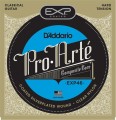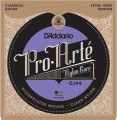— Round. The classic version, which appeared first and still does not lose popularity due to its simplicity, low cost and functionality. From an acoustic point of view, the
round braid contributes to the sonority of the sound. When sliding your fingers along such a string, a characteristic “buzz” occurs, but for many guitarists this is not a disadvantage, and some even use this sound as an additional playing technique.
— Flat. Flatwound strings have an almost flat surface with only the characteristic spiral pattern between the turns. Other things being equal,
flat winding, compared to round winding, gives a softer, warmer, perhaps even slightly muffled tone of sound. Also, such strings allow you to perform more "clean" slides, without a buzzing sound when you move your finger along the string, and wear out the frets less.
— Semi-flat. To obtain such a winding, a round wire is used, which, during processing, is smoothed from the outside. Thus, a
semi-flat winding is a kind of middle option between flat and round: flat on the outside, round on the inside. Thanks to this, it combines many advantages of a flat braid (“careful attitude” to the frets, no noise when sliding a finger) with a rather sonorous sound.
—
Elliptical. The winding of this type in the section has a slightly flattened shape, however, unlike the se
...mi-flat, its surface is closer to the usual round winding, and the turns are quite pronounced. In fact, the "ellipse" is a modification of the round winding, designed to reduce fret wear and at the same time preserve the sonorous and clear sound as much as possible.The diameter of the strings in the set, from thinnest to thickest.
Thicker strings, all other things being equal, provide more volume and richness to the sound, have more overtones, and generally sound richer and warmer (high frequencies are less pronounced in the sound). However, these strings require more tension, which can make them uncomfortable for beginners and inexperienced players who are unaccustomed to high force; and the duration of the sound is relatively low. Conversely, thinner strings are softer to the touch, require less effort, give better sustain, but are thinner and more prone to rattle. Detailed recommendations on the optimal string thickness for different cases can be found in special sources (including documentation for the instrument itself and reference materials from string manufacturers).
Note that the diameter of the strings is directly related to the tension (see below), so one of these parameters is often indicated in the characteristics.

